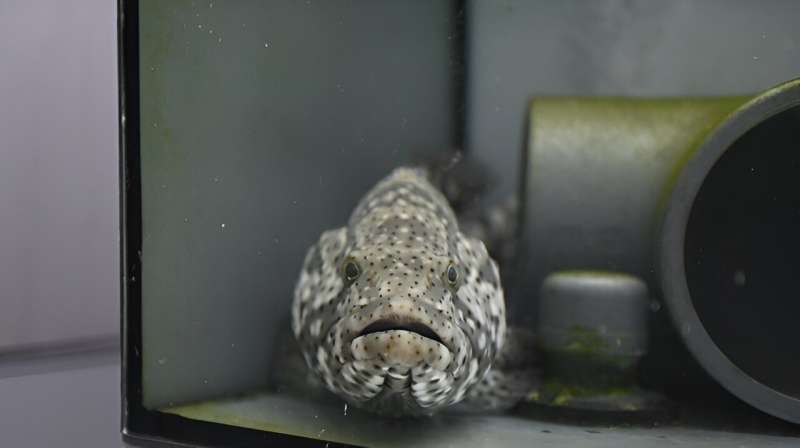This article has been reviewed according to Science X's editorial process and policies. Editors have highlighted the following attributes while ensuring the content's credibility:
fact-checked
peer-reviewed publication
trusted source
proofread
Surprising hormone-related gene activity discovered in the early larval stage of the Malabar grouper

Researchers at the Okinawa Institute of Science and Technology (OIST)'s Marine Climate Change Unit and Marine Eco-Evo-Devo Unit have highlighted patterns of gene activation during Malabar grouper larval development, revealing an unusual early peak of activation of thyroid and corticoid genes during the early larval stage of these fish.
Their paper, published in the journal eLife, is the first study to show that thyroid and corticoid genes are activated twice during larval development, once during the early larval stage and once during metamorphosis. This early activation has never been encountered in any fish species before, making the grouper case unique.
Groupers are meso-predators playing a crucial role in maintaining the balance and health of marine ecosystems. The Malabar grouper (Epinephelus malabaricus), known as Yaito-hata in Japanese, can grow up to 2 meters in length.
However, their popularity and high economic value on the food market has led to overexploitation, with many species at risk of extinction. In response to this threat and to meet continued demand, grouper aquaculture farms have been established in Okinawa and other places in the world.
Grouper aquaculture in Okinawa
"For me, the eco-culture aspect of this study was especially interesting; that these fish are being bred and sold here in Okinawa," Dr. Roger Huerlimann, lead author and molecular biologist in the Marine Climate Change Unit, said.
Research on breeding and raising young Malabar groupers began at the Ishigaki branch of the Okinawa Prefectural Fisheries and Ocean Research Center in 1992. The first successful breeding in Okinawa occurred in 1996. By 1997, the center had achieved the world's first large-scale breeding success, producing more than 200,000 young fish. Currently, approximately 10 Malabar grouper fish farms operate in Okinawa.
RNA analysis reveals unusual hormone activation
A genome is the complete set of genetic material in an organism. Scientists can study how a genome functions by examining the RNA produced by the genome under specific conditions or in certain cells—a process called transcriptomic analysis. This allows them to identify which genes are activated at specific times during different developmental stages.
The researchers examined how genes related to thyroid and corticoid hormones, as well as other biological processes, are expressed in the Malabar grouper during its larval development, which includes a very important step: metamorphosis.
After hatching, the larvae drift in the open ocean for about 60 days, before coming back to coastal environments. During this amazing journey, they experience a dramatic hormone-driven metamorphosis, including the regression of spines and the appearance of an adult-like pigmentation.

"Our genomic analysis clearly shows a high activation of thyroid and corticoid genes at the timing of metamorphosis. In groupers, metamorphosis corresponds with the appearance of an adult-like pigmentation and the disappearance of spines that the larvae have on the dorsal and pectoral fins," Dr. Huerlimann explained.
"What was interesting is that we also found a surge in these genes at the very beginning of the larval development, which we've not seen before in other fish species."
Dr. Natacha Roux, a researcher at Centre de Recherches Insulaires et Observatoire de l'Environnement (CRIOBE) and former researcher in the Computational Neuroethology Unit at OIST, elaborated, "We also measured thyroid hormone and corticoid levels in the larvae and saw an increase of both hormones at the beginning of the larval development, confirming the genomic analysis results.
"The reason of this activation is not known yet, but we hypothesize it may be linked to the development of larval spines, potentially helping in buoyancy and predator deterrence."
Both researchers emphasized that their findings were directly tied to the Motobu Town community's willingness to open their doors to the scientists, without which the project would not have been possible. This allowed the research team to set up a small laboratory in the Okinawa Prefectural Sea Farming Center for sampling and experiments.
Dr. Huerlimann aims to support sustainable aquaculture in Okinawa by helping local aquaculture farmers through his research. "Initially, our goal was to create a reference genome sequence as a foundation for further research," he explained.
"But in the past three years, I've gone around talking to farmers to understand their challenges. Disease management is a significant issue, so I want to see how my research can help address this and other issues they face."
More information: Roger Huerlimann et al, The transcriptional landscape underlying larval development and metamorphosis in the Malabar grouper (Epinephelus malabaricus), eLife (2024). DOI: 10.7554/eLife.94573.3
Journal information: eLife
Provided by Okinawa Institute of Science and Technology




















